check engine light CADILLAC CTS 2009 2.G User Guide
[x] Cancel search | Manufacturer: CADILLAC, Model Year: 2009, Model line: CTS, Model: CADILLAC CTS 2009 2.GPages: 490, PDF Size: 2.68 MB
Page 207 of 490

Automatic Light Control Off
This message displays when the automatic headlamps
are turned off.
Automatic Light Control On
This message displays when the automatic headlamps
are turned on.
Battery Saver Active
This message displays when the system detects
that the battery voltage is dropping below expected
levels. The battery saver system starts reducing certain
features of the vehicle that you may be able to notice.
At the point that the features are disabled, this message
is displayed. It means that the vehicle is trying to
save the charge in the battery.
Turn off all unnecessary accessories to allow the battery
to recharge.
The normal battery voltage range is 11.5 to 15.5 volts.
You can monitor battery voltage on the DIC by pressing
the vehicle information button until Battery Voltage is
displayed.
Battery Volts Low
This message displays when the electrical system is
charging less than 10 volts or the battery has been
drained.
If this message appears immediately after starting the
engine, it is possible that the generator can still recharge
the battery. The battery should recharge while driving,
but may take a few hours to do so. Consider using
an auxiliary charger to boost the battery after returning
home or to a �nal destination. Make sure you follow
the manufacturer’s instructions.
If this message appears while driving or after starting
the vehicle and stays on, have it checked immediately to
determine the cause of this problem.
To help the generator recharge the battery quickly, you
can reduce the load on the electrical system by
turning off the accessories.
The normal battery voltage range is 11.5 to 15.5 volts.
You can monitor battery voltage on the DIC by pressing
the vehicle information button until Battery Voltage is
displayed.
3-59
Page 208 of 490
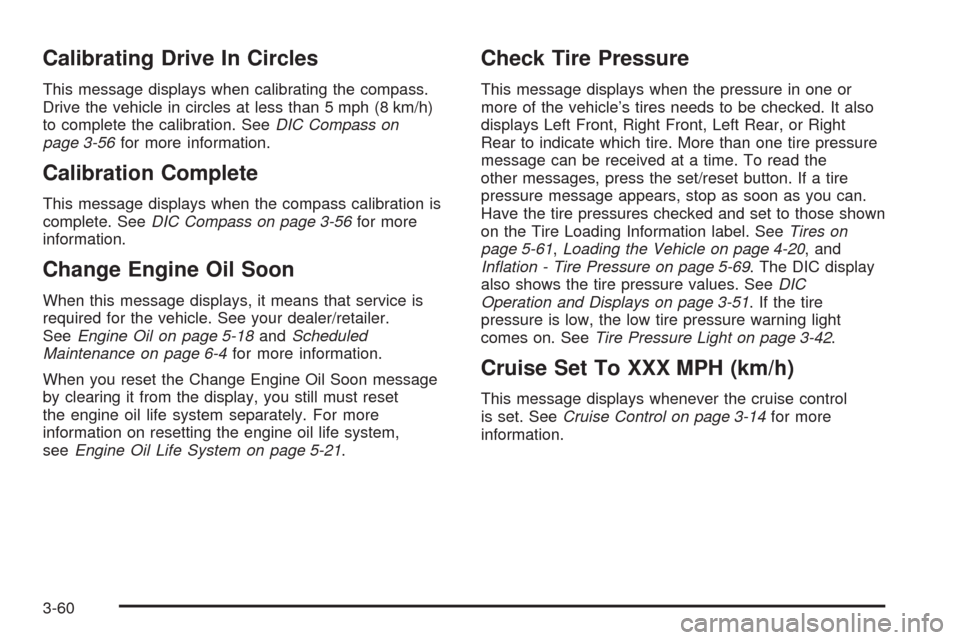
Calibrating Drive In Circles
This message displays when calibrating the compass.
Drive the vehicle in circles at less than 5 mph (8 km/h)
to complete the calibration. SeeDIC Compass on
page 3-56for more information.
Calibration Complete
This message displays when the compass calibration is
complete. SeeDIC Compass on page 3-56for more
information.
Change Engine Oil Soon
When this message displays, it means that service is
required for the vehicle. See your dealer/retailer.
SeeEngine Oil on page 5-18andScheduled
Maintenance on page 6-4for more information.
When you reset the Change Engine Oil Soon message
by clearing it from the display, you still must reset
the engine oil life system separately. For more
information on resetting the engine oil life system,
seeEngine Oil Life System on page 5-21.
Check Tire Pressure
This message displays when the pressure in one or
more of the vehicle’s tires needs to be checked. It also
displays Left Front, Right Front, Left Rear, or Right
Rear to indicate which tire. More than one tire pressure
message can be received at a time. To read the
other messages, press the set/reset button. If a tire
pressure message appears, stop as soon as you can.
Have the tire pressures checked and set to those shown
on the Tire Loading Information label. SeeTires on
page 5-61,Loading the Vehicle on page 4-20, and
Inflation - Tire Pressure on page 5-69. The DIC display
also shows the tire pressure values. SeeDIC
Operation and Displays on page 3-51. If the tire
pressure is low, the low tire pressure warning light
comes on. SeeTire Pressure Light on page 3-42.
Cruise Set To XXX MPH (km/h)
This message displays whenever the cruise control
is set. SeeCruise Control on page 3-14for more
information.
3-60
Page 211 of 490
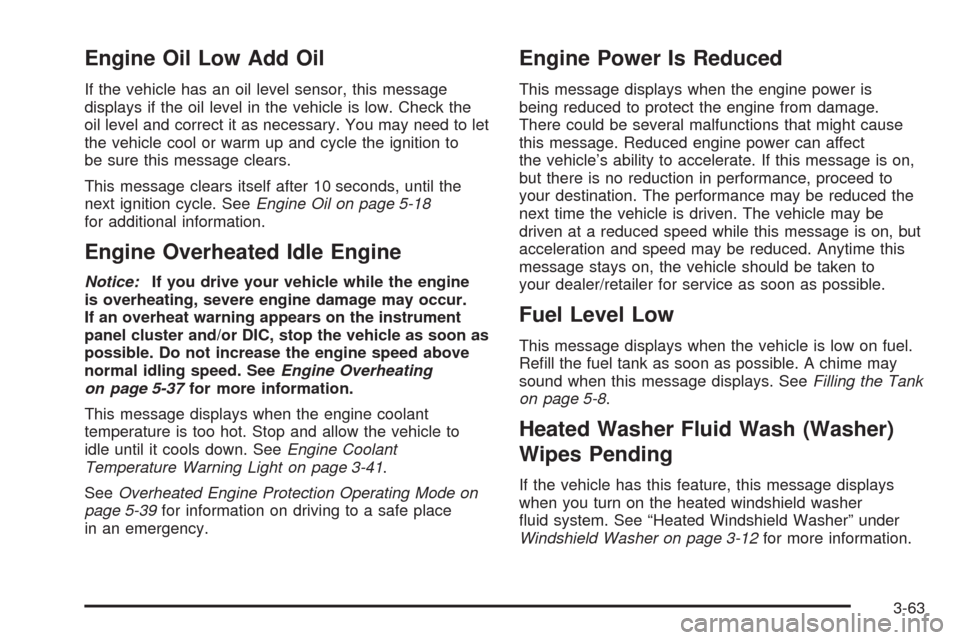
Engine Oil Low Add Oil
If the vehicle has an oil level sensor, this message
displays if the oil level in the vehicle is low. Check the
oil level and correct it as necessary. You may need to let
the vehicle cool or warm up and cycle the ignition to
be sure this message clears.
This message clears itself after 10 seconds, until the
next ignition cycle. SeeEngine Oil on page 5-18
for additional information.
Engine Overheated Idle Engine
Notice:If you drive your vehicle while the engine
is overheating, severe engine damage may occur.
If an overheat warning appears on the instrument
panel cluster and/or DIC, stop the vehicle as soon as
possible. Do not increase the engine speed above
normal idling speed. SeeEngine Overheating
on page 5-37for more information.
This message displays when the engine coolant
temperature is too hot. Stop and allow the vehicle to
idle until it cools down. SeeEngine Coolant
Temperature Warning Light on page 3-41.
SeeOverheated Engine Protection Operating Mode on
page 5-39for information on driving to a safe place
in an emergency.
Engine Power Is Reduced
This message displays when the engine power is
being reduced to protect the engine from damage.
There could be several malfunctions that might cause
this message. Reduced engine power can affect
the vehicle’s ability to accelerate. If this message is on,
but there is no reduction in performance, proceed to
your destination. The performance may be reduced the
next time the vehicle is driven. The vehicle may be
driven at a reduced speed while this message is on, but
acceleration and speed may be reduced. Anytime this
message stays on, the vehicle should be taken to
your dealer/retailer for service as soon as possible.
Fuel Level Low
This message displays when the vehicle is low on fuel.
Re�ll the fuel tank as soon as possible. A chime may
sound when this message displays. SeeFilling the Tank
on page 5-8.
Heated Washer Fluid Wash (Washer)
Wipes Pending
If the vehicle has this feature, this message displays
when you turn on the heated windshield washer
�uid system. See “Heated Windshield Washer” under
Windshield Washer on page 3-12for more information.
3-63
Page 280 of 490
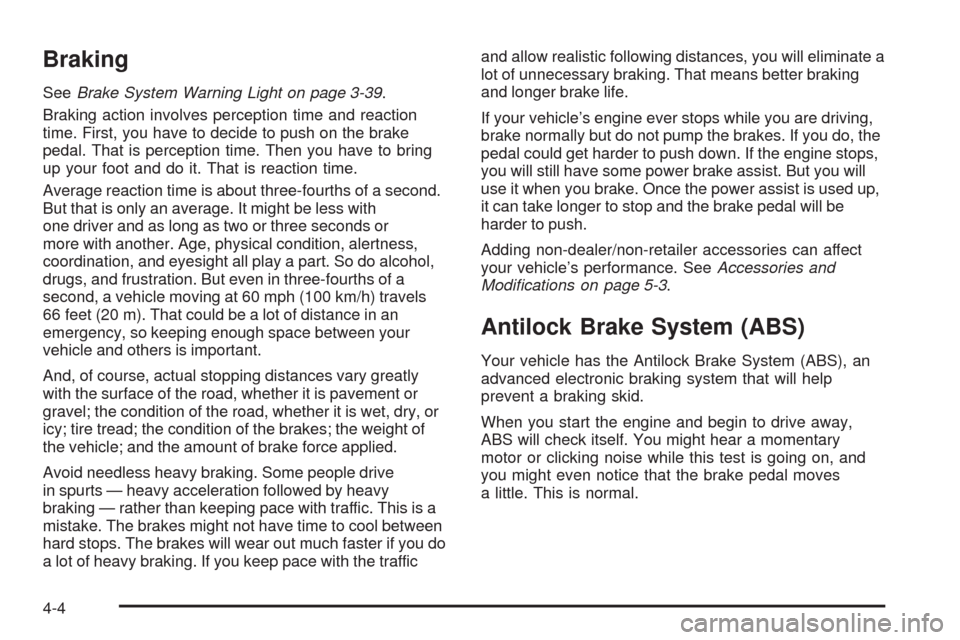
Braking
SeeBrake System Warning Light on page 3-39.
Braking action involves perception time and reaction
time. First, you have to decide to push on the brake
pedal. That is perception time. Then you have to bring
up your foot and do it. That is reaction time.
Average reaction time is about three-fourths of a second.
But that is only an average. It might be less with
one driver and as long as two or three seconds or
more with another. Age, physical condition, alertness,
coordination, and eyesight all play a part. So do alcohol,
drugs, and frustration. But even in three-fourths of a
second, a vehicle moving at 60 mph (100 km/h) travels
66 feet (20 m). That could be a lot of distance in an
emergency, so keeping enough space between your
vehicle and others is important.
And, of course, actual stopping distances vary greatly
with the surface of the road, whether it is pavement or
gravel; the condition of the road, whether it is wet, dry, or
icy; tire tread; the condition of the brakes; the weight of
the vehicle; and the amount of brake force applied.
Avoid needless heavy braking. Some people drive
in spurts — heavy acceleration followed by heavy
braking — rather than keeping pace with traffic. This is a
mistake. The brakes might not have time to cool between
hard stops. The brakes will wear out much faster if you do
a lot of heavy braking. If you keep pace with the trafficand allow realistic following distances, you will eliminate a
lot of unnecessary braking. That means better braking
and longer brake life.
If your vehicle’s engine ever stops while you are driving,
brake normally but do not pump the brakes. If you do, the
pedal could get harder to push down. If the engine stops,
you will still have some power brake assist. But you will
use it when you brake. Once the power assist is used up,
it can take longer to stop and the brake pedal will be
harder to push.
Adding non-dealer/non-retailer accessories can affect
your vehicle’s performance. SeeAccessories and
Modifications on page 5-3.
Antilock Brake System (ABS)
Your vehicle has the Antilock Brake System (ABS), an
advanced electronic braking system that will help
prevent a braking skid.
When you start the engine and begin to drive away,
ABS will check itself. You might hear a momentary
motor or clicking noise while this test is going on, and
you might even notice that the brake pedal moves
a little. This is normal.
4-4
Page 289 of 490

Competitive Driving
Competitive driving may affect the vehicle warranty.
See your warranty book before using your vehicle
for competitive driving.
Notice:If you use your vehicle for competitive
driving, the engine may use more oil than it would
with normal use. Low oil levels can damage the
engine. Be sure to check the oil level often during
competitive driving and keep the level at or near the
upper mark that shows the proper operating range
on the engine oil dipstick. For information on how to
add oil, seeEngine Oil on page 5-18.
CTS-V Only: For competitive driving, it is recommended
that the brake �uid be replaced with a high performance
brake �uid that has a dry boiling point greater than 534°F
(279°C). After conversion to the high performance brake
�uid, follow the brake �uid service recommendations
outlined by the �uid manufacturer. Do not use silicone
or DOT-5 brake �uids.
Driving at Night
Night driving is more dangerous than day driving because
some drivers are likely to be impaired — by alcohol or
drugs, with night vision problems, or by fatigue.Night driving tips include:
Drive defensively.
Do not drink and drive.
Reduce headlamp glare by adjusting the inside
rearview mirror.
Slow down and keep more space between you and
other vehicles because headlamps can only light up
so much road ahead.
Watch for animals.
When tired, pull off the road.
Do not wear sunglasses.
Avoid staring directly into approaching headlamps.
Keep the windshield and all glass on your vehicle
clean — inside and out.
Keep your eyes moving, especially during turns or
curves.
No one can see as well at night as in the daytime.
But, as we get older, these differences increase.
A 50-year-old driver might need at least twice as much
light to see the same thing at night as a 20-year-old.
4-13
Page 309 of 490
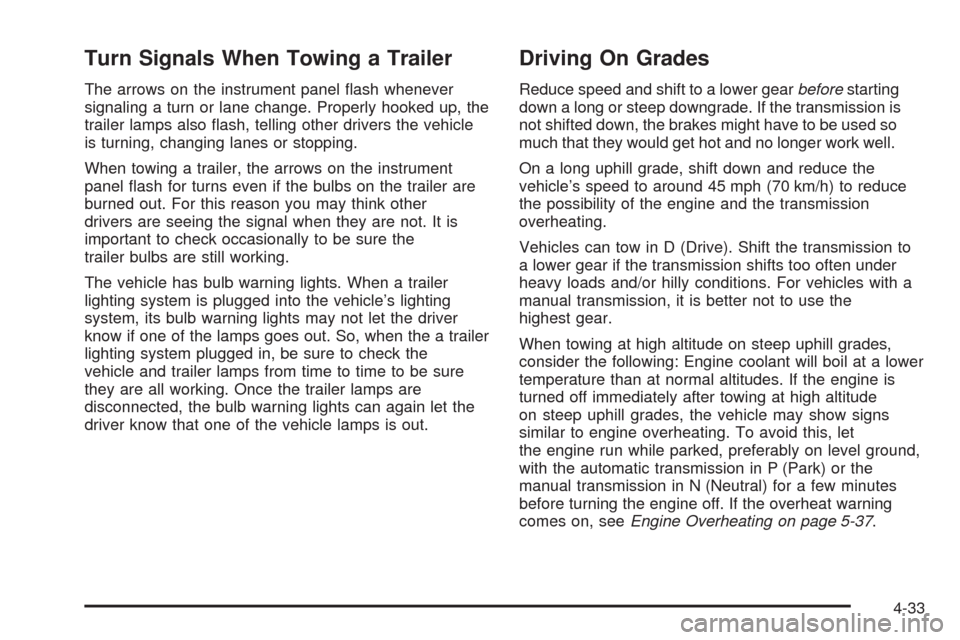
Turn Signals When Towing a Trailer
The arrows on the instrument panel �ash whenever
signaling a turn or lane change. Properly hooked up, the
trailer lamps also �ash, telling other drivers the vehicle
is turning, changing lanes or stopping.
When towing a trailer, the arrows on the instrument
panel �ash for turns even if the bulbs on the trailer are
burned out. For this reason you may think other
drivers are seeing the signal when they are not. It is
important to check occasionally to be sure the
trailer bulbs are still working.
The vehicle has bulb warning lights. When a trailer
lighting system is plugged into the vehicle’s lighting
system, its bulb warning lights may not let the driver
know if one of the lamps goes out. So, when the a trailer
lighting system plugged in, be sure to check the
vehicle and trailer lamps from time to time to be sure
they are all working. Once the trailer lamps are
disconnected, the bulb warning lights can again let the
driver know that one of the vehicle lamps is out.
Driving On Grades
Reduce speed and shift to a lower gearbeforestarting
down a long or steep downgrade. If the transmission is
not shifted down, the brakes might have to be used so
much that they would get hot and no longer work well.
On a long uphill grade, shift down and reduce the
vehicle’s speed to around 45 mph (70 km/h) to reduce
the possibility of the engine and the transmission
overheating.
Vehicles can tow in D (Drive). Shift the transmission to
a lower gear if the transmission shifts too often under
heavy loads and/or hilly conditions. For vehicles with a
manual transmission, it is better not to use the
highest gear.
When towing at high altitude on steep uphill grades,
consider the following: Engine coolant will boil at a lower
temperature than at normal altitudes. If the engine is
turned off immediately after towing at high altitude
on steep uphill grades, the vehicle may show signs
similar to engine overheating. To avoid this, let
the engine run while parked, preferably on level ground,
with the automatic transmission in P (Park) or the
manual transmission in N (Neutral) for a few minutes
before turning the engine off. If the overheat warning
comes on, seeEngine Overheating on page 5-37.
4-33
Page 311 of 490
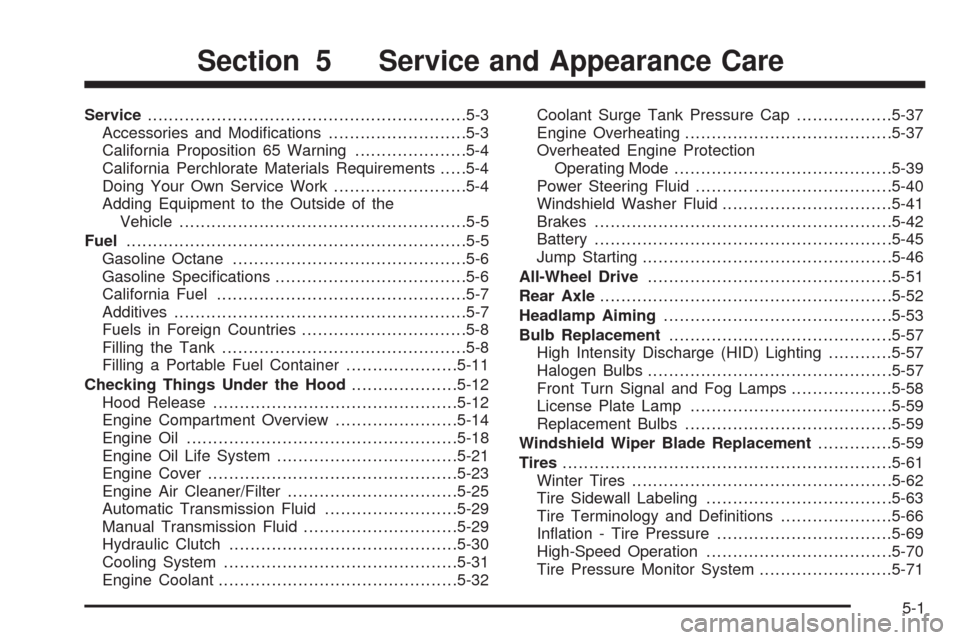
Service............................................................5-3
Accessories and Modi�cations..........................5-3
California Proposition 65 Warning.....................5-4
California Perchlorate Materials Requirements.....5-4
Doing Your Own Service Work.........................5-4
Adding Equipment to the Outside of the
Vehicle......................................................5-5
Fuel................................................................5-5
Gasoline Octane............................................5-6
Gasoline Speci�cations....................................5-6
California Fuel...............................................5-7
Additives.......................................................5-7
Fuels in Foreign Countries...............................5-8
Filling the Tank..............................................5-8
Filling a Portable Fuel Container.....................5-11
Checking Things Under the Hood....................5-12
Hood Release..............................................5-12
Engine Compartment Overview.......................5-14
Engine Oil...................................................5-18
Engine Oil Life System..................................5-21
Engine Cover...............................................5-23
Engine Air Cleaner/Filter................................5-25
Automatic Transmission Fluid.........................5-29
Manual Transmission Fluid.............................5-29
Hydraulic Clutch...........................................5-30
Cooling System............................................5-31
Engine Coolant.............................................5-32Coolant Surge Tank Pressure Cap..................5-37
Engine Overheating.......................................5-37
Overheated Engine Protection
Operating Mode.........................................5-39
Power Steering Fluid.....................................5-40
Windshield Washer Fluid................................5-41
Brakes........................................................5-42
Battery........................................................5-45
Jump Starting...............................................5-46
All-Wheel Drive..............................................5-51
Rear Axle.......................................................5-52
Headlamp Aiming...........................................5-53
Bulb Replacement..........................................5-57
High Intensity Discharge (HID) Lighting............5-57
Halogen Bulbs..............................................5-57
Front Turn Signal and Fog Lamps...................5-58
License Plate Lamp......................................5-59
Replacement Bulbs.......................................5-59
Windshield Wiper Blade Replacement..............5-59
Tires..............................................................5-61
Winter Tires.................................................5-62
Tire Sidewall Labeling...................................5-63
Tire Terminology and De�nitions.....................5-66
In�ation - Tire Pressure.................................5-69
High-Speed Operation...................................5-70
Tire Pressure Monitor System.........................5-71
Section 5 Service and Appearance Care
5-1
Page 328 of 490

Engine Oil
There is an oil pressure
light in the instrument
cluster and an Oil Pressure
Low Stop Engine message
on the Driver Information
Center (DIC).
If the light and/or message appear, check the engine oil
level right away. For more information, see “Oil Pressure
Low Stop Engine” underDIC Warnings and Messages on
page 3-58andOil Pressure Light on page 3-46. You
should check the engine oil level regularly; this is an
added reminder.
Checking Engine Oil
It is a good idea to check the engine oil every time you
get fuel. In order to get an accurate reading, the oil
must be warm and the vehicle must be on level ground.
The engine oil dipstick handle is a yellow loop.
SeeEngine Compartment Overview on page 5-14
for the location of the engine oil dipstick.
1. Turn off the engine and give the oil several minutes
to drain back into the oil pan. If you do not do this,
the oil dipstick might not show the actual level.
2. Pull out the dipstick and clean it with a paper towel
or cloth, then push it back in all the way. Remove it
again, keeping the tip down, and check the level.
5-18
Page 345 of 490

3. Fill the coolant surge tank with the proper mixture,
to slightly above the FROID/FULL COLD line on the
side of the coolant surge tank.4. With the coolant surge tank pressure cap off, start
the engine and let it run until you can feel the upper
radiator hose getting hot. The upper radiator
hose is the top hose coming out of the radiator, on
the passenger side of the vehicle. Watch out for
the engine cooling fans.
By this time, the coolant level inside the coolant
surge tank may be lower. If the level is lower, add
more of the proper mixture to the coolant surge tank
until the level reaches the FROID/FULL COLD
line on the side of the coolant surge tank.
5. Then replace the pressure cap. Be sure the
pressure cap is hand-tight and fully seated.
Notice:If the pressure cap is not tightly installed,
coolant loss and possible engine damage may
occur. Be sure the cap is properly and tightly
secured.
Recheck the coolant level in the bottle next time you
use your vehicle to insure the system is full when cold.
SeeEngine Coolant on page 5-32.
5-35
Page 357 of 490

Notice:Ignoring these steps could result in costly
damage to your vehicle that would not be covered
by your warranty.
Trying to start your vehicle by pushing or pulling it
will not work, and it could damage your vehicle.
1. Check the other vehicle. It must have a 12-volt
battery with a negative ground system.
Notice:If the other vehicle’s system is not a 12-volt
system with a negative ground, both vehicles can
be damaged. Only use vehicles with 12-volt systems
with negative grounds to jump start your vehicle.
2. Get the vehicles close enough so the jumper cables
can reach, but be sure the vehicles are not touching
each other. If they are, it could cause a ground
connection you do not want. You would not be able
to start your vehicle and the bad grounding could
damage the electrical systems.
To avoid the possibility of the vehicles rolling, set
the parking brake �rmly on both vehicles involved
in the jump start procedure. Put an automatic
transmission in P (Park) or a manual transmission
in NEUTRAL before setting the parking brake.Notice:If you leave the radio or other accessories
on during the jump starting procedure, they could be
damaged. The repairs would not be covered by the
warranty. Always turn off the radio and other
accessories when jump starting the vehicle.
3. Turn off the ignition on both vehicles. Unplug
unnecessary accessories plugged into the cigarette
lighter or the accessory power outlets. Turn off
the radio and all lamps that are not needed.
This will avoid sparks and help save both batteries.
And it could save the radio!
4. Open the hoods and locate the positive (+) and
negative (−) terminal locations or the remote
positive (+) and remote negative (−) terminals of the
other vehicle. Then locate the remote positive (+)
location on your vehicle. SeeEngine Compartment
Overview on page 5-14for more information on
locations the terminals.
5-47